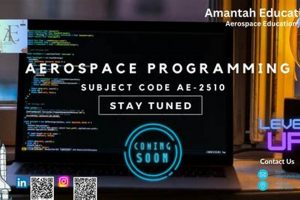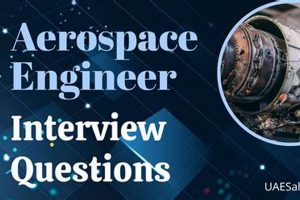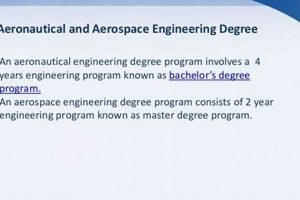A foundational understanding of mathematics and physics is crucial for individuals pursuing advanced studies in the design, development, and testing of aircraft and spacecraft. Strong problem-solving skills, analytical capabilities, and a capacity for abstract thought are essential prerequisites. Familiarity with computer-aided design (CAD) software and programming languages is also highly beneficial.
A robust academic preparation provides the basis for innovation and advancement within this technologically demanding field. Mastery of these fundamental principles facilitates the creation of safer, more efficient, and more sustainable aerospace systems. The ability to apply theoretical knowledge to practical challenges is paramount for success in this discipline.
Therefore, prospective students should concentrate on cultivating expertise in key areas such as calculus, differential equations, linear algebra, Newtonian mechanics, thermodynamics, and fluid dynamics. Furthermore, developing strong communication and teamwork skills will prove invaluable throughout their academic and professional careers. The curriculum will heavily emphasize the practical application of these core concepts.
Essential Guidance for Aspiring Aerospace Engineers
Prospective aerospace engineering students can benefit from focused preparation. A strategic approach can significantly enhance academic performance and future career prospects. The following recommendations provide a framework for developing a strong foundation.
Tip 1: Emphasize Mathematics Proficiency: A solid grounding in calculus, differential equations, linear algebra, and statistics is paramount. Consistent practice and problem-solving are crucial. These mathematical tools underpin nearly all aerospace engineering principles.
Tip 2: Master Fundamental Physics Concepts: Newtonian mechanics, thermodynamics, and electromagnetism are indispensable. Understanding these principles allows for the analysis of forces, energy transfer, and electrical systems within aircraft and spacecraft.
Tip 3: Cultivate Programming Skills: Proficiency in programming languages such as Python, MATLAB, or C++ is highly advantageous. These languages are used for simulation, data analysis, and control system development.
Tip 4: Develop CAD Software Expertise: Familiarity with Computer-Aided Design (CAD) software like SolidWorks or AutoCAD is essential for designing and modeling aerospace components and systems. Hands-on experience with these tools is invaluable.
Tip 5: Engage in Relevant Extracurricular Activities: Participation in science clubs, robotics competitions, or aerospace-related projects provides practical experience and demonstrates a genuine interest in the field. These activities can significantly strengthen college applications.
Tip 6: Seek Out Internships or Research Opportunities: Gaining practical experience through internships at aerospace companies or research institutions offers invaluable insights into the industry and its challenges. These experiences provide a competitive edge upon graduation.
Tip 7: Focus on Strong Communication Skills: Effective written and verbal communication is crucial for collaborating with engineers and presenting technical information clearly. Practice writing technical reports and delivering presentations to refine these skills.
These preparatory steps are not merely academic exercises; they are investments in future success. A proactive approach to developing these core competencies will significantly improve comprehension of advanced topics and prepare individuals for the rigors of aerospace engineering coursework and professional practice.
By prioritizing these fundamental skills and experiences, prospective students can position themselves for success in this demanding yet rewarding field. The benefits of such preparation extend beyond academic achievement to encompass a deeper understanding of the principles governing the aerospace industry and a heightened capacity for innovation.
1. Mathematics
Mathematics serves as a foundational pillar for aerospace engineering, providing the tools and techniques necessary to analyze, model, and predict the behavior of complex systems. The discipline relies heavily on mathematical principles to understand aerodynamics, structural mechanics, propulsion, and control systems. Without a strong mathematical foundation, comprehension of core aerospace concepts becomes severely limited.
Calculus, for instance, is essential for modeling the continuous changes in velocity and acceleration experienced by aircraft during flight. Differential equations are crucial for describing the dynamic behavior of control systems and predicting the stability of aircraft under various conditions. Linear algebra provides the framework for analyzing structural loads and stresses, ensuring the structural integrity of airframes and spacecraft. Furthermore, statistics plays a critical role in analyzing experimental data and assessing the reliability of aerospace components. Consider the design of a wing; mathematical models derived from fluid dynamics equations are used to optimize its shape for maximum lift and minimum drag, a process impossible without a solid grasp of calculus and differential equations.
The ability to apply mathematical principles to real-world engineering problems is a defining characteristic of a successful aerospace engineer. The curriculum for any aspiring engineer therefore places considerable emphasis on mathematical rigor. In summary, mathematics is not merely a prerequisite but an integral part of the core knowledge base required for effective practice in the field, directly influencing the ability to design, analyze, and improve aerospace systems.
2. Physics
Physics provides the fundamental understanding of the natural laws governing the behavior of matter and energy, a prerequisite for comprehending the forces, motion, and interactions inherent in aerospace systems. A strong grasp of physics principles is essential for analyzing and designing aircraft and spacecraft.
- Newtonian Mechanics
Newtonian mechanics governs the motion of objects, making it critical for understanding flight dynamics and trajectory analysis. For example, calculating the forces acting on an aircraft during takeoff, cruise, and landing requires a solid understanding of Newton’s laws of motion. These laws also dictate how rockets achieve orbit, influencing the design of propulsion systems and flight paths. Without a grasp of Newtonian mechanics, predicting and controlling the movement of aerospace vehicles would be impossible.
- Thermodynamics
Thermodynamics concerns the relationships between heat, work, and energy, which are fundamental to understanding propulsion systems and thermal management. Gas turbine engines, used in most aircraft, rely on thermodynamic principles to convert fuel into thrust. Similarly, spacecraft require sophisticated thermal control systems to dissipate heat generated by electronic components and maintain a stable operating temperature in the vacuum of space. Mastery of thermodynamics is vital for designing efficient and reliable aerospace power and cooling systems.
- Fluid Dynamics
Fluid dynamics examines the behavior of liquids and gases, providing the framework for understanding aerodynamics. The shape of an aircraft wing is carefully designed to manipulate airflow, generating lift and minimizing drag. Similarly, understanding the flow of air around a rocket is essential for optimizing its aerodynamic performance. Without knowledge of fluid dynamics, designing efficient and stable aircraft and spacecraft would be unattainable.
- Electromagnetism
Electromagnetism governs the interactions between electric and magnetic fields, essential for designing electrical systems and communication devices used in aerospace applications. Aircraft and spacecraft rely on complex electrical systems for power distribution, control, and navigation. Furthermore, communication with spacecraft requires a thorough understanding of electromagnetic waves and antenna design. A solid foundation in electromagnetism is critical for developing reliable and efficient aerospace electronics.
These physics principles are interconnected and critical for those entering the field. Individuals pursuing degrees must grasp the underlying physical laws. These principles are vital for designing, analyzing, and optimizing aerospace systems, ultimately contributing to advancements in aircraft and spacecraft technology.
3. Programming
The ability to write and understand computer code is increasingly integral to the successful pursuit of aerospace engineering. Programming serves as a foundational tool for simulation, data analysis, and control system development, influencing every stage of the design and development process for aircraft and spacecraft. The computational intensity of modern aerospace projects necessitates proficiency in at least one high-level programming language. For example, simulating airflow around an aircraft wing requires solving complex equations numerically, tasks for which manual calculation is impractical. Consequently, engineers employ programming to create computational fluid dynamics (CFD) models, analyzing airflow patterns and optimizing wing designs for improved performance. The direct impact of programming proficiency is realized in the enhanced efficiency and safety of flight systems.
Furthermore, data analysis plays a critical role in aerospace engineering. Data collected from flight tests, wind tunnel experiments, and satellite telemetry provides valuable insights into the performance and behavior of aerospace systems. Programming skills enable engineers to process and analyze large datasets, identifying trends and anomalies that might otherwise go unnoticed. For instance, Python, with libraries like NumPy and SciPy, is frequently used to analyze sensor data from aircraft engines, detecting potential mechanical failures before they occur. This proactive approach to maintenance, facilitated by programming, enhances the safety and reliability of aircraft operations. Programming is equally essential for developing control systems. Aircraft autopilot systems, spacecraft navigation systems, and robotic control systems rely on sophisticated algorithms to maintain stability, navigate accurately, and perform complex maneuvers. These algorithms are typically implemented using programming languages like C++ or MATLAB. In essence, programming is the language through which aerospace engineers translate theoretical models into practical, functional systems.
In conclusion, programming is no longer a supplementary skill, but rather a core competency for aspiring aerospace engineers. It empowers engineers to simulate complex phenomena, analyze large datasets, and develop sophisticated control systems, enabling advancements in aircraft and spacecraft technology. The challenges of the aerospace industry, such as improving fuel efficiency, enhancing safety, and exploring space, require innovative solutions that are increasingly reliant on programming expertise. Therefore, a strong foundation in programming is indispensable for individuals seeking to contribute meaningfully to this dynamic and technologically advanced field.
4. CAD Software
Computer-Aided Design (CAD) software plays a pivotal role in modern aerospace engineering. It’s not merely a tool for creating technical drawings; it’s an environment for design, simulation, and collaboration. A solid understanding of CAD principles and proficiency in relevant software packages are increasingly essential for individuals pursuing advanced studies in this field.
- 3D Modeling and Visualization
CAD software enables the creation of detailed three-dimensional models of aircraft and spacecraft components. This capability allows engineers to visualize designs in a realistic environment, identifying potential flaws and optimizing shapes for performance and manufacturability. For example, a complex engine turbine blade can be modeled in CAD, allowing engineers to analyze its aerodynamic properties and structural integrity before physical prototyping. These models can then be used for presentations or virtual reality simulations, and can assist in manufacturability reviews, ultimately saving time and resources in the product development cycle.
- Simulation and Analysis Integration
Modern CAD software integrates seamlessly with simulation and analysis tools, facilitating a design-analysis feedback loop. Finite element analysis (FEA) can be performed directly on CAD models to assess structural stresses, thermal behavior, and vibrational characteristics. Computational Fluid Dynamics (CFD) simulations can also be integrated to analyze airflow patterns around aircraft surfaces. This integration allows engineers to iterate on designs rapidly, optimizing performance characteristics before committing to physical prototypes. In the design of an aircraft wing, for example, CAD models can be directly imported into FEA software to analyze stress distribution under flight loads.
- Manufacturing and Production Support
CAD software plays a critical role in translating designs into manufacturable products. CAD models can be directly used to generate toolpaths for CNC machining, ensuring precise manufacturing of complex components. Furthermore, CAD data can be used to create assembly drawings and instructions, streamlining the manufacturing process and reducing errors. When manufacturing a spacecraft component, such as a nozzle for a rocket engine, CAD models can be used to create the precise molds and machining instructions necessary for its production.
- Collaboration and Data Management
CAD software facilitates collaboration among engineers working on complex projects. Cloud-based CAD systems allow designers to share models, track changes, and coordinate efforts in real-time, regardless of location. Integrated data management systems ensure that all team members are working with the most up-to-date design information, minimizing errors and improving communication. For example, a team of engineers working on different parts of an aircraft wing (aerodynamics, structure, control surfaces) can simultaneously access, modify, and comment on the master CAD model stored in a central repository, guaranteeing everyone is working on the latest design iteration.
Proficiency in CAD software is therefore an indispensable asset for any aspiring aerospace engineer. The capacity to create, analyze, and collaborate on designs using these tools is critical for success in this field. The integration of CAD with simulation, manufacturing, and data management systems further highlights its importance in the modern aerospace engineering workflow. These factors strongly correlate with answering “what do i need to study aerospace engineering” and should not be overlooked.
5. Problem-Solving
The capacity for effective problem-solving is a foundational attribute for individuals pursuing aerospace engineering. This skill transcends theoretical knowledge, serving as the linchpin for translating abstract concepts into tangible solutions. A mastery of problem-solving techniques is crucial for navigating the multifaceted challenges inherent in the design, development, and operation of aerospace systems.
- System Analysis and Decomposition
Aerospace systems are characterized by their complexity, often involving numerous interconnected components and subsystems. Effective problem-solving necessitates the ability to decompose complex problems into manageable sub-problems. System analysis techniques allow engineers to identify critical components, analyze their interactions, and prioritize problem-solving efforts. For instance, when addressing issues related to aircraft stability, an engineer might decompose the problem into sub-problems related to aerodynamics, control systems, and structural dynamics. This decomposition enables a targeted and efficient approach to problem resolution, ensuring the stability of the entire system.
- Analytical and Critical Thinking
Aerospace engineering demands rigorous analytical and critical thinking skills. Engineers must be able to evaluate information objectively, identify assumptions, and assess the validity of solutions. Analytical skills are crucial for interpreting data from simulations, experiments, and flight tests. Critical thinking allows engineers to identify potential flaws in designs and propose alternative solutions. For example, when analyzing the performance of a new rocket engine, engineers must critically evaluate the data obtained from test firings, identifying any anomalies and determining their root cause.
- Creative and Innovative Solutions
Many aerospace engineering challenges require creative and innovative solutions. Engineers must be able to think outside the box, generate novel ideas, and develop unconventional approaches. Creativity is particularly important when addressing challenges related to sustainability, efficiency, and performance. For example, the development of new propulsion systems, such as electric or hybrid-electric aircraft, requires innovative solutions to overcome limitations in battery technology and energy storage.
- Implementation and Verification
Effective problem-solving extends beyond the generation of solutions to encompass their implementation and verification. Engineers must be able to translate theoretical solutions into practical designs, implement those designs using appropriate tools and techniques, and verify their performance through testing and analysis. Verification ensures that the implemented solution meets the required specifications and functions as intended. For instance, after designing a new control system for an aircraft, engineers must verify its performance through simulations and flight tests, ensuring that it meets safety and performance requirements.
In summary, problem-solving permeates every facet of aerospace engineering, from the initial design phases to the final stages of testing and operation. It requires a combination of analytical skills, creative thinking, and practical implementation capabilities. The development and refinement of these skills are integral to the curriculum of any aerospace engineering program and are essential for success in the field. These attributes directly addresses “what do i need to study aerospace engineering” as a foundational requirement.
6. Communication
Effective communication is a cornerstone of aerospace engineering practice, facilitating collaboration, knowledge dissemination, and the successful execution of complex projects. Mastery of communication skills is crucial for individuals seeking to contribute effectively to this demanding field.
- Technical Writing and Documentation
Aerospace engineers are frequently tasked with producing detailed technical reports, design specifications, and research papers. Clear and concise writing is essential for conveying complex information accurately and unambiguously. For example, writing a failure analysis report requires meticulous documentation of the incident, data collected, and the subsequent investigation results, presenting the information in a structured and easily comprehensible manner. The ability to produce high-quality technical documentation is a critical asset for any aerospace engineer.
- Oral Presentations and Briefings
Aerospace engineers must often present their work to colleagues, clients, and stakeholders. Effective oral presentation skills are crucial for conveying complex technical information in a clear and engaging manner. This includes tailoring the message to the audience, using visual aids effectively, and answering questions confidently. For instance, presenting the results of a wind tunnel test to a team of design engineers requires the ability to explain complex aerodynamic phenomena clearly and concisely, using graphs and charts to illustrate key findings. Confidence and clarity in oral communication are paramount.
- Interpersonal Communication and Teamwork
Aerospace engineering projects typically involve teams of engineers from diverse backgrounds. Effective interpersonal communication skills are essential for fostering collaboration, resolving conflicts, and building consensus. Engineers must be able to listen actively, provide constructive feedback, and communicate their ideas effectively. For example, collaborating with a team of electrical, mechanical, and software engineers to integrate different subsystems into a spacecraft requires the ability to understand diverse perspectives and communicate technical information clearly across disciplines. Strong interpersonal skills are key to successful teamwork.
- Visual Communication and Data Representation
Aerospace engineers rely heavily on visual aids to convey complex data and concepts. Expertise in creating charts, graphs, diagrams, and simulations is essential for presenting information effectively. These visual aids are critical for communicating design ideas, analysis results, and performance metrics. For example, creating a detailed 3D model of a new aircraft design allows stakeholders to visualize its features and understand its aerodynamic characteristics. Effective visual communication enhances comprehension and facilitates informed decision-making.
The aforementioned communication skills are inseparable from the core competencies required for successful engagement in aerospace engineering. The ability to effectively communicate technical information, collaborate with colleagues, and present ideas persuasively is crucial for advancing innovation and solving complex problems in this field. These capabilities are what contributes to “what do i need to study aerospace engineering”, underscoring its vital role.
Frequently Asked Questions
This section addresses common inquiries regarding the academic requirements and preparation needed for pursuing studies in aerospace engineering. The information presented aims to provide clarity and guidance for prospective students.
Question 1: Is a background in advanced mathematics absolutely necessary?
A strong foundation in advanced mathematics, including calculus, differential equations, and linear algebra, is not merely beneficial but essential. These mathematical tools underpin nearly all core aerospace engineering principles and are used extensively throughout the curriculum.
Question 2: How important is practical experience prior to commencing formal studies?
While not always mandatory, practical experience through internships, research opportunities, or relevant extracurricular activities can significantly enhance understanding and application of theoretical concepts. Such experiences also demonstrate a commitment to the field.
Question 3: Which programming languages are most valuable for aerospace engineering students to learn?
Proficiency in programming languages such as Python, MATLAB, or C++ is highly advantageous. These languages are used for simulation, data analysis, and control system development, making them indispensable tools in the field.
Question 4: Is a deep understanding of physics more important than hands-on engineering skills?
Both are crucial. A deep understanding of physics provides the theoretical foundation for understanding aerospace phenomena. However, practical engineering skills enable the application of that knowledge to the design and development of real-world systems. Neither should be neglected.
Question 5: How critical is the ability to work effectively in team-based projects?
The ability to collaborate effectively within a team is paramount. Aerospace engineering projects are typically complex and require the expertise of individuals with diverse skill sets. Strong communication and teamwork skills are essential for success.
Question 6: Can a student with a non-technical background successfully transition into aerospace engineering studies?
While challenging, it is possible. A student with a non-technical background would need to dedicate significant effort to acquiring the necessary foundational knowledge in mathematics, physics, and related technical areas. A structured self-study plan or preparatory coursework may be beneficial.
These frequently asked questions highlight the importance of a solid academic foundation, practical experience, and strong communication skills for aspiring aerospace engineers. The pursuit of these competencies will significantly enhance the likelihood of success in this demanding yet rewarding field.
The subsequent section will delve into specific career paths available to graduates with aerospace engineering degrees.
In Conclusion
This article has explored the essential elements that constitute adequate preparation for aerospace engineering studies. The analysis has emphasized the critical importance of a robust foundation in mathematics and physics, coupled with practical skills in programming and CAD software. Furthermore, the necessity of strong problem-solving abilities and effective communication has been highlighted as indispensable for success in this demanding field. The amalgamation of these attributes represents a comprehensive framework for prospective students.
Prospective students should rigorously assess their existing skills and diligently pursue opportunities to enhance their proficiency in these areas. This proactive approach will not only facilitate academic success but also position individuals for meaningful contributions to the advancement of aerospace technology. The aerospace domain necessitates relentless dedication to continuous learning and skill refinement. Therefore, those who invest in these core competencies will be poised to shape the future of aerospace engineering.







